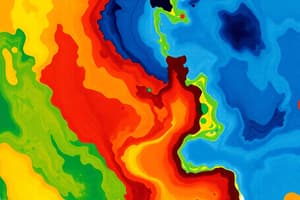Podcast
Questions and Answers
What is the latitude measurement at the Equator?
What is the latitude measurement at the Equator?
- 45°
- 90° N
- 0° (correct)
- 23.5° S
At which latitude does the Tropic of Cancer lie?
At which latitude does the Tropic of Cancer lie?
- 66.5° N
- 45° N
- 23.5° N (correct)
- 0°
Which coordinate system format is correct?
Which coordinate system format is correct?
- Longitude, Latitude
- Longitude, Degree
- Latitude, Longitude (correct)
- Latitude, Degree
What does the Prime Meridian represent?
What does the Prime Meridian represent?
Which of the following lines marks the southernmost point of the Tropic zone?
Which of the following lines marks the southernmost point of the Tropic zone?
What is the latitude of the Arctic Circle?
What is the latitude of the Arctic Circle?
What is the purpose of latitude and longitude?
What is the purpose of latitude and longitude?
Which line approximately marks the change of one calendar day?
Which line approximately marks the change of one calendar day?
What does latitude measure?
What does latitude measure?
Which city is located at the coordinates 40.7128° N, 74.0060° W?
Which city is located at the coordinates 40.7128° N, 74.0060° W?
Flashcards are hidden until you start studying
Study Notes
Latitude
- Definition: Latitude refers to the geographic coordinate that specifies the north-south position of a point on the Earth's surface.
- Measurement: Measured in degrees, ranging from 0° at the Equator to 90° at the poles (North or South).
- Key Lines:
- Equator: 0° latitude, divides the Earth into Northern and Southern Hemispheres.
- Tropic of Cancer: 23.5° N, marks the northernmost point of the Tropic zone.
- Tropic of Capricorn: 23.5° S, marks the southernmost point of the Tropic zone.
- Arctic Circle: 66.5° N, marks the latitude where the sun does not set on the summer solstice.
- Antarctic Circle: 66.5° S, marks the latitude where the sun does not rise on the winter solstice.
Longitude
- Definition: Longitude refers to the geographic coordinate that specifies the east-west position of a point on the Earth's surface.
- Measurement: Measured in degrees, ranging from 0° at the Prime Meridian to 180° east or west.
- Key Lines:
- Prime Meridian: 0° longitude, runs through Greenwich, England, divides the Earth into Eastern and Western Hemispheres.
- International Date Line: Approximately 180° longitude, opposite the Prime Meridian, determines the change of one calendar day to the next.
Coordinate System
- Format: Coordinates are expressed as (latitude, longitude).
- Examples:
- New York City: 40.7128° N, 74.0060° W.
- Sydney: 33.8688° S, 151.2093° E.
Importance
- Navigation: Essential for mapping, navigation, and global positioning systems (GPS).
- Geography: Helps in understanding climate zones, ecosystems, and human geography.
Visualization
- Grid System: Latitude and longitude create a grid overlay on the globe, aiding in locating any point on Earth.
- Maps: Used in various forms of maps, including political, physical, and thematic maps.
Latitude
- Latitude indicates the north-south positioning of a location on Earth's surface, integral for geographical referencing.
- It is quantified in degrees from 0° at the Equator to 90° at both poles (North or South).
- Equator: The central line at 0° latitude, dividing the globe into Northern and Southern Hemispheres.
- Tropic of Cancer: Located at 23.5° N, it signifies the northernmost reach of the Tropic region.
- Tropic of Capricorn: Found at 23.5° S, it denotes the southernmost limit of the Tropic zone.
- Arctic Circle: Situated at 66.5° N, it marks the latitude where the sun remains above the horizon during the summer solstice.
- Antarctic Circle: Located at 66.5° S, indicating the latitude where the sun remains below the horizon during the winter solstice.
Longitude
- Longitude identifies the east-west positioning of a location on Earth's surface, essential for navigation and geolocation.
- It is measured in degrees, starting from 0° at the Prime Meridian, extending to 180° both east and west.
- Prime Meridian: The zero-degree longitude line running through Greenwich, England, partitioning the Earth into Eastern and Western Hemispheres.
- International Date Line: Roughly at 180° longitude, this line marks where the date changes, serving as a reference for timekeeping.
Coordinate System
- Geographic coordinates are represented in the format (latitude, longitude).
- Examples:
- New York City: 40.7128° N, 74.0060° W
- Sydney: 33.8688° S, 151.2093° E
Importance
- Latitude and longitude are crucial for navigation, enhancing accuracy in mapping and global positioning systems (GPS).
- They enable a better understanding of climate zones, ecosystems, and human geography, which are essential for various fields of study.
Visualization
- Latitude and longitude create an effective grid system on the globe, allowing precise location identification of any point on Earth.
- Widely utilized in different types of maps, including political, physical, and thematic, to convey various geographical information.
Studying That Suits You
Use AI to generate personalized quizzes and flashcards to suit your learning preferences.




